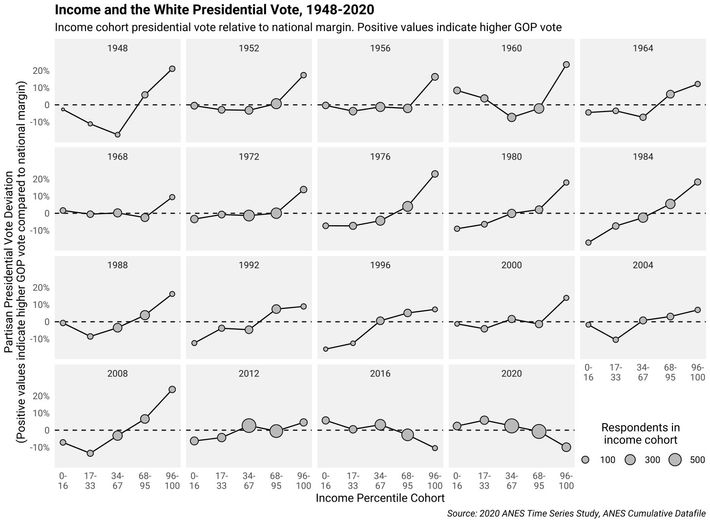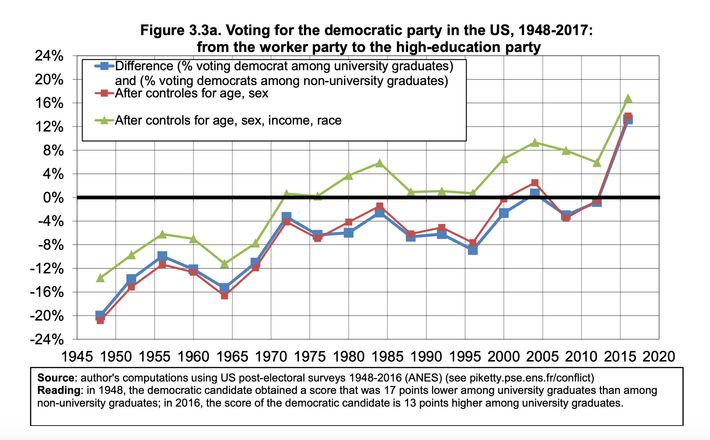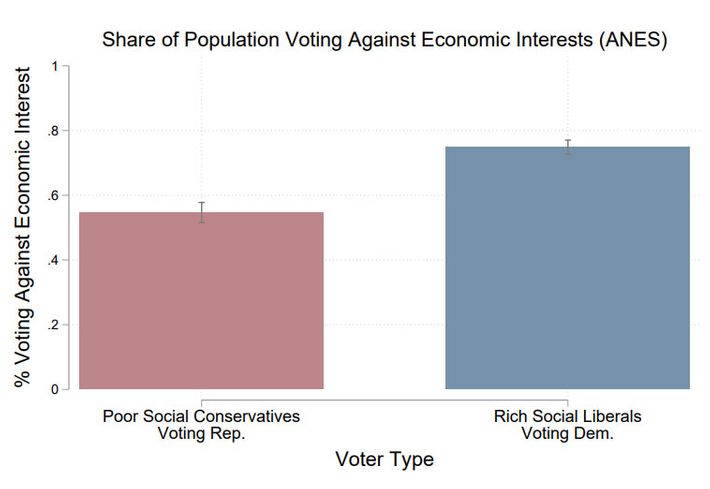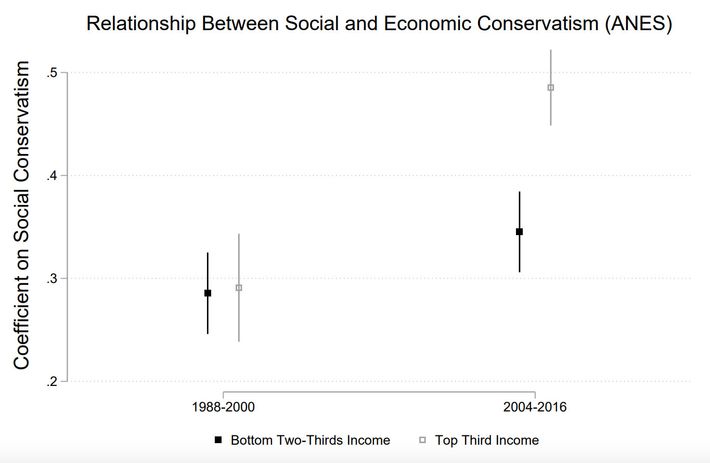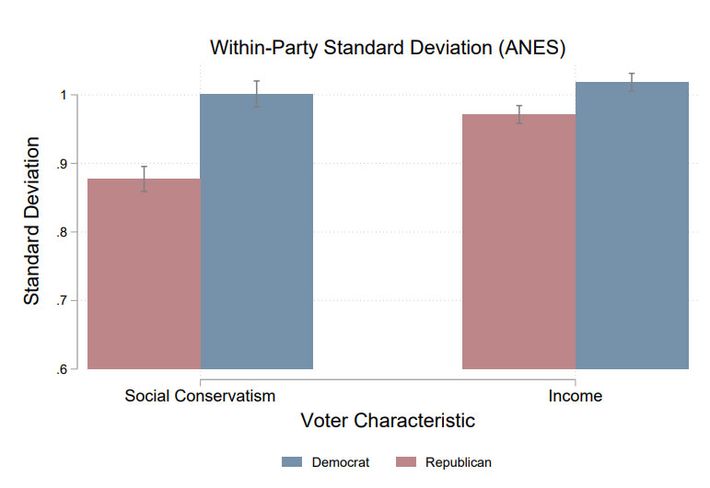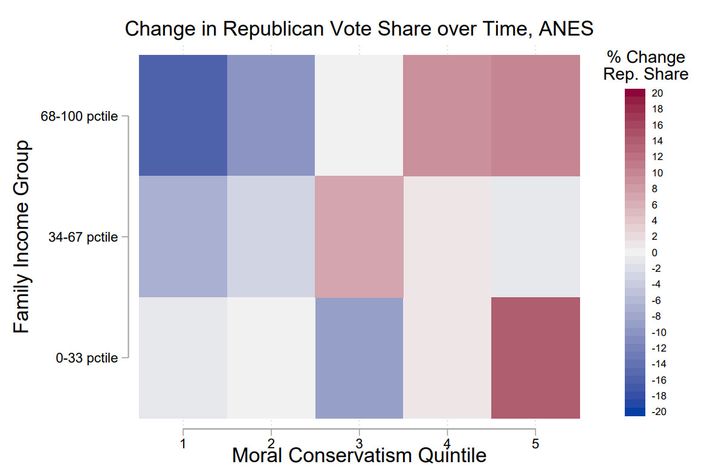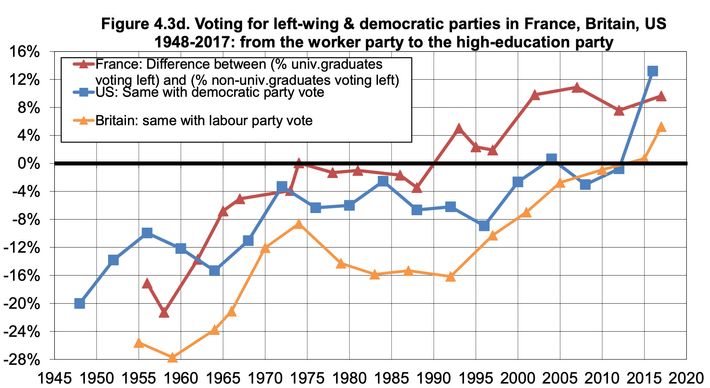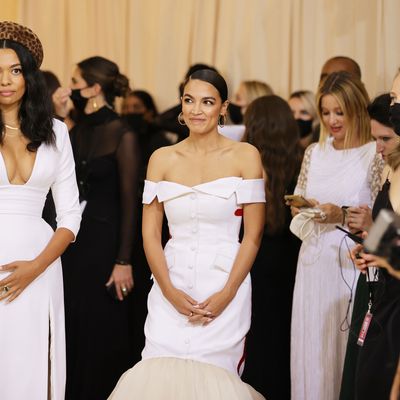
The Democratic coalition has never been wealthier than it is today. And the Democratic Party is more economically progressive than it’s been in decades.
In every presidential election from 1948 to 2012, white voters in the top 5 percent of America’s income distribution were more Republican than those in the bottom 95 percent.
Now, the opposite is true: Among white Americans, the rich voted to the left of the middle class and the poor in 2016 and 2020, while the poor voted to the right of the middle class and the rich.
This inversion in white America’s voting patterns was the culmination of a long-term trend. Throughout the second half of the 20th century, Americans without college degrees were more likely to vote blue than university graduates. But that class gap began narrowing in the late 1960s, before finally flipping in 2004. As the French economist Thomas Piketty illustrated in a 2018 paper:
The erosion of traditional class allegiances in voting — a phenomenon some have dubbed “class dealignment” — has been most stark among white voters. But in 2020, the phenomenon crossed racial lines. According to the Pew Research Center, Joe Biden won college-educated Hispanic voters by 25 points more than he did non-college-educated ones.
In recent years, as red America grew more working class — and blue America more bourgeois — many pundits predicted that the major parties’ economic platforms would become less distinct. Increasingly reliant on affluent voters, the Democrats would lose enthusiasm for progressive redistribution, while the GOP’s deepening dependence on working-class voters would force it to adopt less-plutocratic priorities.
That prophecy has yet to be fulfilled.
In 1996, President Bill Clinton assembled the most working-class Democratic coalition of the past four decades. Yet his platform was one of the most economically conservative in the party’s modern history, including a celebration of welfare cuts and promises to “rein in big government” and “slash burdensome regulations.” A quarter-century later, the leadership of a much more bourgeois Democratic Party is presently fighting to take money away from capitalists and invest it in a giant expansion of unconditional welfare benefits. The Democratic president, for his part, is singing paeans to the public sector, declaring, “No matter how challenging or how complex the problems we’re going to face, government by and for the people is still the best way to deliver for all of our people.”
Across the aisle, Donald Trump’s “worker’s party” unanimously opposes Biden’s proposed expansion of the welfare state, insisting that the government must reduce spending and concentrate relief on the truly needy, such as the long-suffering heirs of $12 million estates.
To be sure, some congressional Democrats are currently threatening to kill Biden’s redistributive agenda. And this contingent includes a few lawmakers who represent high-income constituencies. Yet there is no tight correlation between the median income of a congressional Democrat’s district and the economic progressivism of their voting record. Anna Eshoo represents the wealthiest House district in the United States, and she’s been a reliable supporter of Biden’s program in general and his push for price controls on pharmaceuticals in particular (a cause of much Democratic infighting). Ro Khanna represents the country’s second-richest district and is among the most economically left-wing members of Congress. Joe Manchin, meanwhile, hails from one of America’s poorest states and is nevertheless the Senate’s most conservative Democrat.
In truth, Biden’s redistributive agenda isn’t stalling because his party is beholden to affluent voters but because it holds too few Senate seats. The president’s white-collar coalition has not stopped him from assembling the most pro-labor executive-branch policies of any modern president. And in states where the Democrats boast large legislative majorities, the party’s reliance on high-income voters has not prevented it from moving left on economic policy over the past decade. This year, New York enacted a “millionaires tax” to sustain its exceptionally high level of social-welfare spending, and several other blue states are mulling similar plans to soak the rich.
From one angle, the fact that the Democratic Party has simultaneously grown more affluent and more economically progressive is no paradox. Contrary to conventional wisdom, recent survey data suggests that professional-class voters are, in the aggregate, more left wing than working-class ones on many economic questions. In an analysis of the 2020 electorate, political scientist Alan I. Abramowitz found that college-educated white voters espoused more progressive views on issues of “social welfare” than did non-college-educated whites.
That finding is buttressed by the results of Maine’s 2017 referendum on Medicaid expansion. Given the opportunity to expand the availability of socialized health insurance, the most highly educated parts of the Pine Tree State voted in favor of the provision, while the least affluent regions, which stood to derive greater material benefit from the policy, voted against it. Illinois’s 2020 vote on establishing a progressive state-income tax yielded similarly anti-materialist results. Although the initiative attracted relatively little support outside major urban centers, it still fared better in affluent inner-ring suburbs than it did in the state’s poorest rural counties.
If such data points make the Democratic Party’s ideological trajectory less mysterious, they make America’s political divisions even more so. What explains working-class voters’ counterintuitive economic conservatism or the relative progressivism of the professional class?
One explanation is that these ideological tendencies are mere consequences of voters’ partisanship. If you control for party identification, voters with lower incomes tend to be more economically progressive but less socially liberal than those with high incomes. Thus it’s plausible that the typical, white working-class ex-Democrat defected to red America for cultural reasons and then, over time, began to absorb their new political community’s economic orthodoxy. And one could tell a parallel story about affluent Democrats: After arriving in blue America as culture-war refugees, upper-middle-class voters gradually converted to their new land’s welfarist gospel.
What neither of these narratives explain, however, is why cultural values displaced material interests as the key determinant of partisanship. Which is to say: They don’t explain why socially conservative, working-class voters once tended to back parties of the center left but now lean toward those of the right, nor why socially liberal professionals have made the opposite political journey.
Happily, a recent study from political scientists at Harvard and Vanderbilt tackles this question.
In “Morals As Luxury Goods and Political Polarization,” Benjamin Enke, Mattias Polborn, and Alex A. Wu provide an elegantly simple explanation for class dealignment: As people get richer, they give more weight to moral considerations — and less to material ones — when formulating their ideological beliefs and partisan preferences.
This theory is somewhat intuitive. If you are a socially liberal billionaire in 2021, the material costs of supporting a party that affirms your cultural values but wishes to raise your marginal tax rate are all but negligible. Even Elizabeth Warren’s wealth tax would scarcely make a dent in your net worth. For a socially conservative coal miner in the Great Depression era, however, the potential cost of supporting a party that “owned the libs” — but spurned the unemployed — was malnourishment. Thus it makes some sense that the more materially secure voters are, the more likely they’ll be to cast their ballots on the basis of their cultural values.
Beyond its logical soundness, the paper’s foundational premise enjoys a great deal of empirical support. This is in part because it is not very original. The political scientist Ronald Inglehart put forward a similar theory of why voters had started to prioritize “postmaterialist values” decades ago. And the World Values Survey has consistently substantiated Inglehart’s theory: In any given year, rich survey respondents tend to report greater concern with values and rights than with material security, while poor respondents evince the opposite preference. Further, as average incomes have increased over time, the American population as a whole has grown more post-material in its concerns.
The “Morals As Luxury Goods” paper’s original contribution is to show that post-materialism can explain a wide variety of oddities in contemporary politics. From Inglehart’s basic insight, the researchers derive several corollaries:
• Over the course of industrial development, as entire societies grow wealthier, voters across the income spectrum will become more inclined to prioritize moral concerns over material ones.
• Rich social liberals will be more likely to vote against their material interests than poor social conservatives, since the former pay a lower cost for prioritizing cultural concerns.
• Over time, voters will become more likely to hold uniformly conservative or uniformly liberal views. This is because, in a society with economic growth, working-class social conservatives become more materially secure over time (working-class Americans have higher living standards today than they did in the 1930s) and therefore find it more “affordable” to apply their inegalitarian moral convictions to economic matters. By the same token, upper-middle-class social liberals find it increasingly painless to embrace the material implications of a progressive moral outlook.
• The Democratic Party will have more internal diversity than the GOP, in terms of both its cultural views and its income levels (because poor moral conservatives have a stronger incentive to vote with their pocketbooks than rich moral liberals do).
• Over time, political parties will likely polarize over social issues. This is because, as rich social liberals move left and working-class social conservatives move right, the major parties will adjust their platforms to reflect their greater internal consensus about cultural matters. As a result, the parties will become more distinct on social issues, which will further increase the incentive of culturally conservative Democrats to become Republicans and socially liberal Republicans to become Democrats — ideological sorting that will encourage the parties to become even more distinct on social issues, in a self-reinforcing cycle. Culture-war politics ensues.
All of these claims are consistent with recent history. As we’ve already seen, materialist voting declined as the U.S. got wealthier. Using data from the American National Election Studies (ANES), the researchers show that affluent social liberals are indeed about 35 percent more likely to vote for Democrats than poor social conservatives are to vote Republican.
Polls also show that voters have become more ideologically consistent over time. Today, Americans with conservative social views are much more likely to also espouse conservative economic views than they were two decades ago. Notably, this increase in ideological coherence has been far larger among the richest third of Americans than it has been among the bottom two-thirds. That disparity is also consistent with the paper’s hypothesis: Owing to income inequality, the top third of Americans enjoyed a much larger increase in living standards over the past two decades than the bottom third did.
Survey data demonstrates that the Democratic coalition is more internally divided on social issues — and more socioeconomically diverse — than the Republican one.
The notion that the two major parties have grown more distinct on social issues over time is both readily apparent to a lay observer of U.S. politics and supported by a wealth of political-science literature. That voters have both responded to this ideological polarization — and fueled it — by sorting themselves according to their moral convictions is also in keeping with survey data: Over the past three decades, rich moral liberals and poor moral conservatives were exceptionally likely to switch parties.
This empirical data establishes post-materialism’s plausibility. But it can’t prove the theory’s validity. Yes, Americans grew wealthier over the past half-century. And yes, social issues became increasingly salient to our politics over that period. But a lot of other stuff has been happening “over time” too. And it’s impossible to control for all of history’s variables.
There’s no way to fully overcome that problem. But “Morals As a Luxury Good” makes an effort to account for it: To help establish causality, the researchers built a mathematical model that internalizes their theory’s assumptions. They then used that model to run simulations of voter behavior over time and show that these simulations resemble real-life voting patterns.
As a grand theory of political development, post-materialism has its virtues. It offers a coherent explanation for why the Democratic base has grown more affluent and why this has not (yet) caused the party to move right on economic policy. Unlike some popular theories of the New Deal coalition’s demise, post-materialism also makes sense of the fact that center-left parties throughout the West have seen remarkably similar coalitional changes. The Democratic Party’s strategic decisions probably can’t explain why British Labour and the French Socialists also saw their voting bases grow more college-educated over the past quarter-century. Western countries did not all elect Bill Clinton, but they did all experience economic growth over the past 25 years.
On the other hand, post-materialism’s detachment from history is a bit disconcerting. In “Morals As a Luxury Good,” voters and political parties look like ants or automata, their actions shaped not by social movements, personal reflections, or contingent events but by a simple utility function that’s sensitive to changes in GDP.
It’s plausible that, all else being equal, getting richer makes human beings less materialistic in their voting behavior. But it’s difficult to believe that this was the driving force behind the rise of the culture wars during an epoch that also witnessed the upending of centuries-old gender roles, the advance of LGBTQ+ rights, the democratization of higher education, the fall of America’s racial caste system, and the collapse of Western Europe’s colonial empires. All of these developments seem like they would, by themselves, increase the salience of conflicts that political scientists code as “social” or “moral” (even as they all have profound material consequences). And much the same can be said of recent changes in the global media landscape.
Perhaps people are so inclined to vote on the basis of cultural affinity that working-class voters were bound to cease concentrating under the banner of left-wing parties as soon as the welfare state insulated them from absolute poverty. But it’s hard to accept such Newtonian political theorems in the face of history’s myriad contingencies. Can anyone say with confidence what class politics in the West would look like today if the October Revolution never happened? Or if center-left parties had never embraced neoliberal globalization and austerity? Modernization did not happen in a laboratory. We can’t tweak a few variables and then run it again.
All this said, post-materialism is too consistent with available data — and too influential among political scientists and practitioners — for its skeptics to ignore. It might not offer a wholly satisfying explanation for the culture war’s supersession of class politics. But any such explanation will need to account for the correlations it illuminates.



